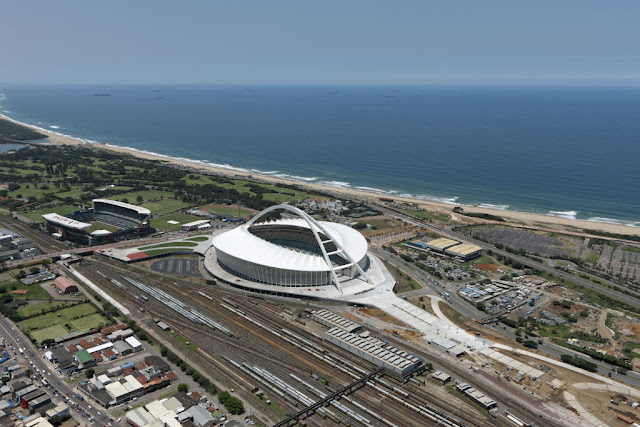gmp architekten
Post By:Kitticoon Poopong
 |
| Photo © Courtesy of Marcus Bredt |
"The shape of the bowl results from the interaction of the circular roof structure with the triple-radius geometry of the arena."
gmp architekten
 |
| Photo © Courtesy of Marcus Bredt |
 |
| Photo © Courtesy of Marcus Bredt |
description by gmp architekten
In its competition brief of 2006, the city of Durban invited designs for a multi-functional stadium for 70,000 to 85,000 spectators that would become an architectural icon and city landmark.
Our Ibhola Lethu Consortium won the competition to build the new Durban stadium, and was subsequently responsible for the design and the management of construction. This project group consisted of a total of 32 South African architectural firms plus German partners von Gerkan, Marg and Partners (gmp) as consultant architects and Schlaich, Bergermann und Partner (sbp) as conceptual structural engineers.
 |
| Photo © Courtesy of Marcus Bredt |
 |
| Photo © Courtesy of Marcus Bredt |
 |
| Photo © Courtesy of Marcus Bredt |
 |
| Photo © Courtesy of Marcus Bredt |
 |
| Photo © Courtesy of Marcus Bredt |
 |
| Photo © Courtesy of Marcus Bredt |
 |
| Photo © Courtesy of Marcus Bredt |
 |
| Photo © Courtesy of Marcus Bredt |
 |
| Photo © Courtesy of Marcus Bredt |
The great arch carries the weight of the inner membrane roof. The unusual geometry of the cable system is derived logically from the structure. Radial prestressing cables are attached to the external edge of the roof all round the stadium and the great arch on one side and the inner edge of the roof on the other, thus forcing the latter into an almond shape. The PTFE-coated roof membrane admits 50% of the sunlight into the arena while also providing shade.
 |
| Photo © Courtesy of Marcus Bredt |
 |
| Photo © Courtesy of Marcus Bredt |
The perforated façade membrane of profiled metal sheeting rises to the outer edge of the roof, forming a lively pattern of light and shadow and offering glimpses of the interior, which lends the stadium a light and airy feel. The compression ring and façade are carried on precast concrete columns below and hollow box steel columns above, the height and angle of inclination varying around the stadium from approx. 30m with a 90° inclination to about 50m with a 60° inclination. The façade membrane of perforated metal sheeting provides protection against driving rain, strong winds and direct sunlight without excluding the outside world.
 |
| Photo © Courtesy of Marcus Bredt |
 |
| Photo © Courtesy of Marcus Bredt |
 |
| Photo © Courtesy of Marcus Bredt |
 |
| Photo © Courtesy of Marcus Bredt |
 |
Photo © Courtesy of Marcus Bredt |
The roof surfaces on either side of the great arch are illuminated on top by a line of LEDs mounted directly on the arch. The rest of the roof membrane is lit from below by floodlights installed on the catwalk. Atmospheric quality and functional efficiency combine to put Durban’s new icon in the right light.
 |
Photo © Courtesy of Marcus Bredt |
 |
Photo © Courtesy of Marcus Bredt |
 |
Photo © Courtesy of Marcus Bredt |
 |
Photo © Courtesy of Marcus Bredt |
 |
Photo © Courtesy of Marcus Bredt |
 |
Photo © Courtesy of Marcus Bredt |
 |
Photo © Courtesy of Marcus Bredt |
 |
Photo © Courtesy of Marcus Bredt |
 |
Photo © Courtesy of Marcus Bredt |
 |
Photo © Courtesy of Marcus Bredt |
 |
Photo © Courtesy of Marcus Bredt |
 |
site plan--drawing Courtesy of gmp architekten |
 |
level 1 floor plan--drawing Courtesy of gmp architekten |
 |
level 3 floor plan--drawing Courtesy of gmp architekten |
 |
level 4 floor plan--drawing Courtesy of gmp architekten |
 |
level 5 floor plan--drawing Courtesy of gmp architekten |
 |
level 6 floor plan--drawing Courtesy of gmp architekten |
 |
roof plan--drawing Courtesy of gmp architekten |
 |
section X-X,Y-Y--drawing Courtesy of gmp architekten |
 |
| Sectional perspective--drawing Courtesy of gmp architekten |
The people
Project: Moses Mabhida Stadium
Location: Durban, South Africa
Competition: 2006 – 1st prize
Architect: gmp architekten – von Gerkan, Marg and Partners Architects
Design: Volkwin Marg and Hubert Nienhoff with Holger Betz
Project leaders: Holger Betz 06/2006–09/2007, Burkhard Pick, Elisabeth Menne (09/2007–02/2009)
Staff (design) in alphabetical order: Christian Blank, Alberto Franco Flores, Rüdiger von Helmolt, Jochen Köhn, Martin Krebes, Helge Lezius, Florian Schwarthoff, Kristian Uthe-Spencker
Staff (execution) in alphabetical order: Barbara Düring, Robert Essen, Alberto Franco Flores, Chris Hättasch, Martin Paul, Michèle Rüegg, Susan Türke
Planning consortium with: Ibhola Lethu Consortium, Theunissen Jankowitz Architects, Ambro Afrique Architects, Osmond Lange Architects, NSM Designs, Mthulusi Msimang Architects, SA
Structural concept and design roof: Schlaich Bergermann und Partner – Knut Göppert with Markus Balz
Structural engineering: BKS (Pty) Ltd
Project management: Ibhola Lethu Pro-ject Management JV
General contractor: Group Five, WBHO + Pandev JV
Client: Municipality of Durban (eThekwini Municipality), Strategic Projects Unit (SPU)
Construction period: 2006–2009
Gross floor area: 92.300 m2
Tiers: 3
Seats: 70.000 for FIFA WC 2010, 56.000 permanent, 85.000 for Olympic mode
VIP seats: 6.090
VIP boxes: 130
VIP seats: 1.807
Places for wheelchair users: 80
Places for press: 63
Underground parking places for cars: 1.500
Length of the stadium: 290 m
Width of the stadium: 290 m
Length of the arch: 340 m
Highest point of the arch: 105 m
PTFE-membrane panels surface area: 40.000 m²